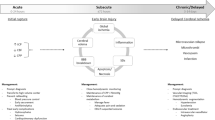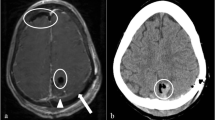Abstract
Purpose
Surgical outcome after shunt insertion in pediatric hydrocephalus can vary greatly. Although first shunt survival rates and complications have been studied by several teams, much less is known about survival and complications of subsequent systems. The goals of this study were to evaluate the surgical outcome in a series of pediatric patients followed for a long time and establish the differences between first and subsequent extracranial shunt survival and complications.
Methods
We undertook a retrospective study in pediatric patients treated with ventriculoperitoneal shunts between 2000 and 2015 at our institution. Surgical outcome was assessed, and different shunt survival curves were studied with Kaplan-Meier. Complications related to each shunt failure were examined and compared.
Results
A total of 166 patients underwent 425 procedures, with a mean follow-up period of 93 months. The median number of shunt revision surgeries was 2. Shunt survival rates were better with the first shunt compared to those with the subsequent shunts. The main complication necessitating system revision surgery was overdrainage, the frequency of proximal and distal dysfunctions was similar in all the shunt failures, and isolated ventricle and infection were more frequent in younger patients. Shunt-related infections accounted for 7 % of the procedures, and the shunt independence rate was 10 %.
Conclusions
The frequency of complications related to shunt failure in pediatric patients changes during follow-up. A strict protocol of overdrainage detection and active treatment could explain the need for repeat surgeries and the progressively shorter shunt survival time in our series.



Similar content being viewed by others
References
Aschoff A, Kremer P, Hashemi B, Kunze S (1999) The scientific history of hydrocephalus and its treatment. Neurosurg Rev 22(2–3):67–93, discussion 94-5
Beez T, Sarikaya-Seiwert S, Bellstädt L, Mühmer M, Steiger HJ (2014) Role of ventriculoperitoneal shunt valve design in the treatment of pediatric hydrocephalus—a single center study of valve performance in the clinical setting. Childs Nerv Syst 30(2):293–297. doi:10.1007/s00381-013-2244-z
Bergsneider M, Egnor MR, Johnston M, Kranz D, Madsen JR, McAllister JP 2nd, Stewart C, Walker ML, Williams MA (2006) What we don’t (but should) know about hydrocephalus. J Neurosurg 104(3 Suppl):157–159
Cheok S, Chen J, Lazareff J (2014) The truth and coherence behind the concept of overdrainage of cerebrospinal fluid in hydrocephalic patients. Childs Nerv Syst 30(4):599–606. doi:10.1007/s00381-013-2327-x
Czosnyka Z, Czosnyka M, Richards HK, Pickard JD (2002) Laboratory testing of hydrocephalus shunts—conclusion of the U.K. Shunt evaluation programme. Acta Neurochir (Wien) 144(6):525–538, discussion 538
Drake JM, Kestle JR, Milner R, Cinalli G, Boop F, Piatt J Jr, Haines S, Schiff SJ, Cochrane DD, Steinbok P, MacNeil N (1998) Randomized trial of cerebrospinal fluid shunt valve design in pediatric hydrocephalus. Neurosurgery 43(2):294–303, discussion 303-5
Eymann R, Steudel WI, Kiefer M (2007) Pediatric gravitational shunts: initial results from a prospective study. J Neurosurg 106(3 Suppl):179–184
Farahmand D, Hilmarsson H, Högfeldt M, Tisell M (2009) Perioperative risk factors for short term shunt revisions in adult hydrocephalus patients. J Neurol Neurosurg Psychiatry 80(11):1248–1253. doi:10.1136/jnnp.2007.141416
Gruber RW, Roehrig B (2010) Prevention of ventricular catheter obstruction and slit ventricle syndrome by the prophylactic use of the Integra antisiphon device in shunt therapy for pediatric hypertensive hydrocephalus: a 25-year follow-up study. J Neurosurg Pediatr 5(1):4–16. doi:10.3171/2008.7.17690
Hanlo PW, Cinalli G, Vandertop WP, Faber JA, Bøgeskov L, Børgesen SE, Boschert J, Chumas P, Eder H, Pople IK, Serlo W, Vitzthum E (2003) Treatment of hydrocephalus determined by the European Orbis Sigma Valve II survey: a multicenter prospective 5-year shunt survival study in children and adults in whom a flow-regulating shunt was used. J Neurosurg 99(1):52–57
Hatlen TJ, Shurtleff DB, Loeser JD, Ojemann JG, Avellino AM, Ellenbogen RG (2012) Nonprogrammable and programmable cerebrospinal fluid shunt valves: a 5-year study. J Neurosurg Pediatr 9(5):462–467. doi:10.3171/2012.1.PEDS10482
Kandasamy J, Dwan K, Hartley JC, Jenkinson MD, Hayhurst C, Gatscher S, Thompson D, Crimmins D, Mallucci C (2011) Antibiotic-impregnated ventriculoperitoneal shunts—a multi-centre British paediatric neurosurgery group (BPNG) study using historical controls. Childs Nerv Syst 27(4):575–581. doi:10.1007/s00381-010-1290-z
Kestle JR, Riva-Cambrin J, Wellons JC 3rd, Kulkarni AV, Whitehead WE, Walker ML, Oakes WJ, Drake JM, Luerssen TG, Simon TD, Holubkov R, Hydrocephalus Clinical Research Network (2011) A standardized protocol to reduce cerebrospinal fluid shunt infection: the Hydrocephalus Clinical Research Network Quality Improvement Initiative. J Neurosurg Pediatr 8(1):22–29. doi:10.3171/2011.4.PEDS10551
Khan F, Shamim MS, Rehman A, Bari ME (2013) Analysis of factors affecting ventriculoperitoneal shunt survival in pediatric patients. Childs Nerv Syst 29(5):791–802. doi:10.1007/s00381-012-2004-5
Kulkarni AV, Riva-Cambrin J, Butler J, Browd SR, Drake JM, Holubkov R, Kestle JR, Limbrick DD, Simon TD, Tamber MS, Wellons JC 3rd, Whitehead WE, Hydrocephalus Clinical Research Network (2013) Outcomes of CSF shunting in children: comparison of Hydrocephalus Clinical Research Network cohort with historical controls: clinical article. J Neurosurg Pediatr 12(4):334–338. doi:10.3171/2013.7.PEDS12637
Martínez-Lage JF, Almagro MJ, Del Rincón IS, Pérez-Espejo MA, Piqueras C, Alfaro R, Ros de San Pedro J (2008) Management of neonatal hydrocephalus: feasibility of use and safety of two programmable (Sophy and Polaris) valves. Childs Nerv Syst 24(5):549–556
McGirt MJ, Buck DW, Sciubba D, Woodworth GF, Carson B, Weingart J, Jallo G (2007) Adjustable vs. set-pressure valves decrease the risk of proximal shunt obstruction in the treatment of pediatric hydrocephalus. Childs Nerv Syst 23(3):289–295
Notarianni C, Vannemreddy P, Caldito G, Bollam P, Wylen E, Willis B, Nanda A (2009) Congenital hydrocephalus and ventriculoperitoneal shunts: influence of etiology and programmable shunts on revisions. J Neurosurg Pediatr 4(6):547–552. doi:10.3171/2009.7.PEDS08371
Pattavilakom A, Xenos C, Bradfield O, Danks RA (2007) Reduction in shunt infection using antibiotic impregnated CSF shunt catheters: an Australian prospective study. J Clin Neurosci 14(6):526–531
Pollack IF, Albright AL, Adelson PD (1999) A randomized, controlled study of a programmable shunt valve versus a conventional valve for patients with hydrocephalus. Hakim-Medos Investigator Group. Neurosurgery 45(6):1399–1408, discussion 1408-11
Preuss M, Kutscher A, Wachowiak R, Merkenschlager A, Bernhard MK, Reiss-Zimmermann M, Meixensberger J, Nestler U (2015) Adult long-term outcome of patients after congenital hydrocephalus shunt therapy. Childs Nerv Syst 31(1):49–56. doi:10.1007/s00381-014-2571-8
Shah SS, Hall M, Slonim AD, Hornig GW, Berry JG, Sharma V (2008) A multicentre study of factors influencing cerebrospinal fluid shunt survival in infants and children. Neurosurgery 62(5):1095–1102. doi:10.1227/01.neu.0000325871.60129.23, discussion 1102-3
Stein SC, Guo W (2007) A mathematical model of survival in a newly inserted ventricular shunt. J Neurosurg 107(6 Suppl):448–454
Stone JJ, Walker CT, Jacobson M, Phillips V, Silberstein HJ (2013) Revision rate of pediatric ventriculoperitoneal shunts after 15 years. J Neurosurg Pediatr 11(1):15–19. doi:10.3171/2012.9.PEDS1298
Symss NP, Oi S (2015) Is there an ideal shunt? A panoramic view of 110 years in CSF diversions and shunt systems used for the treatment of hydrocephalus: from historical events to current trends. Childs Nerv Syst 31(2):191–202. doi:10.1007/s00381-014-2608-z
Thomale UW, Gebert AF, Haberl H, Schulz M (2013) Shunt survival rates by using the adjustable differential pressure valve combined with a gravitational unit (proGAV) in pediatric neurosurgery. Childs Nerv Syst 29(3):425–431. doi:10.1007/s00381-012-1956-9
Tuli S, Drake J, Lawless J, Wigg M, Lamberti-Pasculli M (2000) Risk factors for repeated cerebrospinal shunt failures in pediatric patients with hydrocephalus. J Neurosurg 92(1):31–38
Vinchon M, Rekate H, Kulkarni AV (2012) Pediatric hydrocephalus outcomes: a review. Fluid Barriers CNS 9(1):18. doi:10.1186/2045-8118-9-18
Weinzierl MR, Hans FJ, Stoffel M, Oertel MF, Korinth MC (2012) Experience with a gravitational valve in the management of symptomatic overdrainage in children with shunts. J Neurosurg Pediatr 9(5):468–472. doi:10.3171/2012.1.PEDS11110
Wong JM, Ziewacz JE, Ho AL, Panchmatia JR, Bader AM, Garton HJ, Laws ER, Gawande AA (2012) Patterns in neurosurgical adverse events: cerebrospinal fluid shunt surgery. Neurosurg Focus 33(5), E13. doi:10.3171/2012.7.FOCUS12179
Author information
Authors and Affiliations
Corresponding author
Ethics declarations
Conflict of interest
The authors report no conflict of interest concerning the materials or methods used in this paper. No external funds were received for this study.
Rights and permissions
About this article
Cite this article
Iglesias, S., Ros, B., Martín, Á. et al. Surgical outcome of the shunt: 15-year experience in a single institution. Childs Nerv Syst 32, 2377–2385 (2016). https://doi.org/10.1007/s00381-016-3206-z
Received:
Accepted:
Published:
Issue Date:
DOI: https://doi.org/10.1007/s00381-016-3206-z




